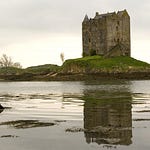Welcome back to "A Scottish Castle, A Day," brought to you by bagtownclans.com. I’m your host, Colin MacDonald, and today we journey to East Lothian, where the yellow towers of Dirleton Castle stand high on a rocky outcrop, just a few miles west of North Berwick. As one of Scotland’s oldest surviving castles, Dirleton has seen its fair share of Scottish history, from Norman knights and English invaders to clan feuds and sieges during the English Civil War.
Dirleton Castle is a striking fortress whose imposing silhouette stands out, surrounded by lush, beautifully maintained gardens. But don't let the idyllic setting fool you—this romantic site has a history of violence and upheaval, making it much more than just a picturesque ruin. The original structure was built in the 13th century by the de Vaux family, Anglo-Norman knights invited to Scotland by King David I. It has since been expanded, destroyed, rebuilt, and abandoned, each phase of its history leaving a mark on the stone walls.
The de Vaux family, originally from Rouen, France, began construction of Dirleton Castle around 1225 under the leadership of John de Vaux, whose family had been granted the barony of Dirleton. The site of the castle was carefully chosen—built on a rocky knoll and surrounded by marshland and a deep moat, Dirleton’s natural defenses made it a formidable stronghold. The castle's original layout featured a series of round and square towers arranged around the site, their placement dictated by the natural contours of the rock. The most notable of these towers was the keep, still largely intact today, which offered both a defensive position and living quarters for the lord and his family.
Dirleton Castle also served an important strategic purpose. Perched on the agricultural lands of East Lothian, it guarded the coastal routes leading to Edinburgh from the south, making it a prime target during periods of conflict. And conflict there was, especially during the Wars of Scottish Independence.
Dirleton played a key role during Edward I of England's invasion of Scotland. In 1298, English forces, under the command of Bishop Antony Bek, besieged the castle, which held out for months until Edward's victory at the Battle of Falkirk allowed for the deployment of siege engines. The mighty walls of Dirleton finally fell, and the English occupied the fortress for years. It wasn’t until Robert the Bruce came to power that the Scots regained control. As a measure to prevent future English use, the castle’s towers were "slighted," or deliberately demolished to make the fortress uninhabitable.
But Dirleton Castle would not remain in ruins for long. In 1350, the Haliburton family came into possession of the castle when John Haliburton married the de Vaux heiress. Under the Haliburtons, Dirleton saw a massive phase of reconstruction. A new gatehouse, a great hall, and vaulted kitchens were added, using the stumps of the ruined 13th-century towers as foundations. The Haliburtons transformed the castle into one of the finest noble residences in Scotland, blending defensive military architecture with the emerging trend of more comfortable living spaces.
The next chapter in Dirleton’s history came in the 16th century when the castle passed to the Ruthven family. This period saw not just architectural but also landscape changes, as the Ruthvens added a walled garden outside the castle walls, one of the first of its kind in Scotland. The Ruthvens also constructed the Ruthven Range, a residential building that brought additional comfort to the inner courtyard. However, their time at Dirleton was marked by controversy, as the Ruthvens became embroiled in several political plots. The most notorious of these was the Gowrie Conspiracy in 1600, in which John Ruthven, 3rd Earl of Gowrie, was accused of plotting to assassinate King James VI. Following the conspiracy, the Ruthvens were executed, and their lands, including Dirleton, were forfeited to the Crown.
By 1650, Dirleton once again found itself embroiled in conflict—this time during the Third English Civil War. A group of Scottish moss-troopers—essentially guerrilla fighters—were using Dirleton as a base to harass English forces under Oliver Cromwell. Cromwell’s army retaliated, bombarding the castle and breaching its walls with mortars. After capturing Dirleton, Cromwell's troops dismantled much of what was left, leaving the castle in ruins once again.
By the late 17th century, Dirleton Castle had been largely abandoned. In 1663, it was purchased by the Nisbet family, who chose to build a new, more comfortable manor at Archerfield nearby. For a time, the castle became a quarry, with local builders taking stone from the ruins to construct cottages and walls. However, the Nisbets maintained the gardens, preserving some of the beauty that had once surrounded the fortress. The garden's history stretches back to the 16th century, but what visitors see today is largely a 20th-century reimagining, including a Victorian herbaceous border that holds the Guinness World Record as the longest in the world.
In 1923, Dirleton Castle was placed into state care, and since then, Historic Environment Scotland has worked to maintain the ruins and the stunning gardens that surround them. Visitors today can explore the well-preserved dungeons, kitchens, and gatehouse, and imagine life in a medieval fortress that stood at the heart of some of Scotland's most tumultuous times.
Whether you're interested in its military history, the romantic tales of the Ruthvens, or simply want to take in the breathtaking gardens, Dirleton Castle offers something for every visitor. Its yellow sandstone towers, standing tall against the lush greenery of East Lothian, are a reminder of the fortress's long and eventful history—a history that continues to captivate those who visit today.
Thanks for joining us on this episode of "A Scottish Castle, A Day." Be sure to tune in next time, when we’ll explore another hidden gem in Scotland’s long and storied landscape. I'm Colin MacDonald, and until then, Slán go fóill!










